In the world of birds, some species love to eat snakes. This is called ophiophagy. Birds like eagles, hawks, owls, and secretary birds hunt snakes. They use special skills and techniques to catch and eat them.
Key Takeaways:
- Numerous bird species, including eagles, hawks, owls, and secretary birds, are equipped to hunt and consume snakes as part of their diet.
- Birds that prey on snakes exhibit specialized hunting techniques, such as careful observation, swift aerial attacks, and the use of their sharp talons and beaks.
- Snake-hunting birds inhabit a variety of habitats, including grasslands, forests, and deserts, where they seek out their slithering prey.
- While many birds are capable of consuming snakes, smaller species often prefer alternative food sources like seeds, insects, or smaller prey.
- Certain bird species, such as the Secretarybird and some hawks, are known to target and overcome even venomous snakes as part of their diet.
An Introduction to Ophiophagy in Birds
The amazing behavior of ophiophagy means birds eat snakes. These birds that eat snakes have special traits. They can hunt, catch, and eat snakes safely.
Ophiophagy: The Dietary Habit of Consuming Snakes
Birds that eat snakes have special skills. They have better senses and are agile. They can also resist snake venom. These traits help them catch and eat snakes well.
Adaptations for Ophiophagy in Birds
Ophiophagous birds help control snake numbers. They keep their ecosystems balanced. Their hunting skills and adaptations make them important predators. They stop snakes from taking over and keep the food chain balanced.
“Ophiophagy is a remarkable adaptation that allows certain birds to thrive as specialized snake hunters, playing a vital role in the ecological balance of their habitats.”
Birds of Prey: Skilled Snake Hunters
A group of raptors, like eagles, falcons, and hawks, are known for their hunting skills. They have sharp eyesight, fast reflexes, and strong talons. These birds of prey can spot, swoop down, and catch snakes with great precision.
Eagles, Falcons, and Hawks
Species like the Bald Eagle, Golden Eagle, Red-tailed Hawk, and falcons are great snake hunters. They use different hunting methods, like flying fast or setting up ambushes, to catch snakes. Their birds of prey snake diet keeps the ecosystem balanced and shows how these eagles, hawks, and falcons have adapted over time.
Owls: Nocturnal Snake Predators
Owls are nocturnal snake-eating birds that hunt at night. Owls, including the Great Horned Owl, Barred Owl, and Burrowing Owl, fly quietly and have sharp eyesight. They use their powerful talons to catch snakes as part of their diet. These owls as snake predators help control snake populations, especially at night.
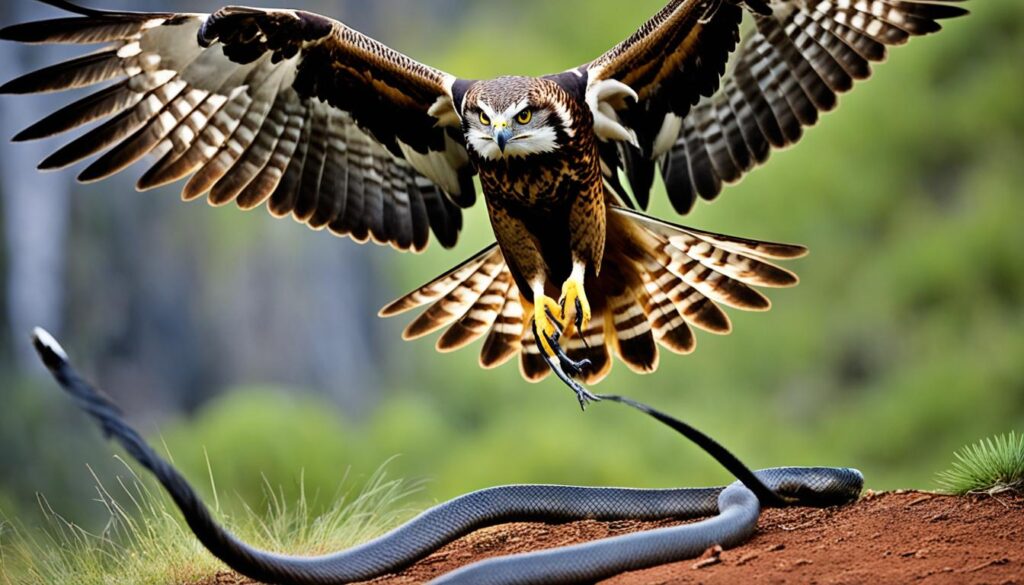
“Owls are not immune to snake venom, but they rely on their hunting skills and speed to avoid being bitten while preying on both venomous and non-venomous snakes.”
Other Avian Snake Eaters
Birds of prey are famous for hunting snakes, but other birds also eat them. Herons, egrets, and cranes catch and eat smaller snakes in wetlands. Roadrunners chase down and kill snakes on the ground. Kites can grab snakes from the ground or air, showing how many birds eat snakes.
Herons, Egrets, and Cranes
Herons, egrets, and cranes are birds that eat snakes but aren’t raptors. They live in wetlands and use their sharp beaks to catch and eat snakes. These birds are great hunters and are known as snake predators.
Roadrunners and Kites
Roadrunners and kites also hunt and eat snakes. Roadrunners are fast and can catch snakes on the ground. Kites fly high and can grab snakes from below. These birds help control snake populations in the ecosystem.
From wetland birds to fast roadrunners and high-flying kites, many birds eat snakes. This shows how these non-raptor birds help keep nature balanced.
Techniques for Hunting Snakes
Birds that hunt snakes use many techniques to catch them. Hawks and kites are great at flying fast and swooping down on snakes. They grab them from the ground or while they’re in the air. 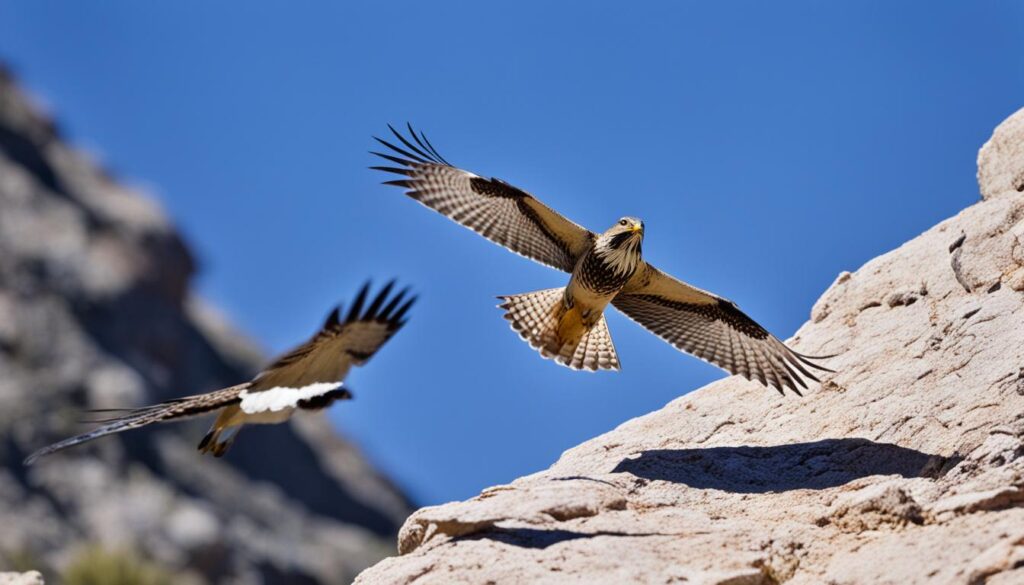
Aerial Pursuit and Swooping Attacks
These birds have amazing bird hunting techniques for snakes. They use their speed and agility for aerial pursuit of snakes and swooping attacks on snakes. They can spot snakes from far away and catch them in the air or on the ground.
Grasping and Subduing with Talons and Beaks
Eagles and owls use their strong talons and beaks to capture snakes. They grab, subdue, and eat their prey. Their special hunting ways help them be successful avian snake hunters.
What birds eat snakes?
A wide range of bird species eat snakes. This includes big raptors and small birds that live on the ground. These avian snake predators can be found in many places like grasslands, forests, deserts, and wetlands.
The snake-consuming bird species list includes eagles, hawks, falcons, owls, herons, egrets, cranes, roadrunners, and kites. Each bird has special ways to catch and eat snakes.
Skilled Snake Hunters
- Eagles, falcons, and hawks are known for their great vision and flying skills. They can spot and catch snakes with ease.
- Owls are silent flyers with sharp senses. They are great at hunting snakes, especially at night.
- Herons, egrets, and cranes use their long, sharp beaks to catch and hold snakes in wet areas.
- Roadrunners and kites are fast and smart. They chase and catch snakes on the ground.
“Birds of prey like hawks and eagles are known to be very skilled at hunting and eating snakes, using their sharp talons and beaks to capture and tear apart their prey.”
Snake-eating birds are important for the environment. They help keep snake numbers in check. This stops snakes from being a problem for people or disrupting nature.
Overcoming the Challenge of Venomous Snakes
Many birds that hunt snakes face a big challenge with venomous snakes. But, some birds that eat venomous snakes have amazing ways to beat this threat. They have venom resistance and even immunity to snake venom. This lets them safely eat even the most dangerous snakes. They are key to keeping ecosystems balanced where venomous snakes live.
Venom Resistance and Immunity in Birds
Birds like eagles, hawks, and owls have special ways to fight off snake venom. This venom resistance helps them grab and hold venomous snakes safely. Some birds are even immune to snake venom, so they can eat venomous snakes without getting hurt.
These birds are fast, agile, and have strong claws and beaks. This gives them a big edge when hunting and catching dangerous snakes. By eating venomous snakes, these birds that eat venomous snakes help keep their ecosystems balanced.
“The adaptations that allow birds to overcome the challenge of venomous snakes are truly remarkable, showcasing the remarkable evolution of these avian predators.”
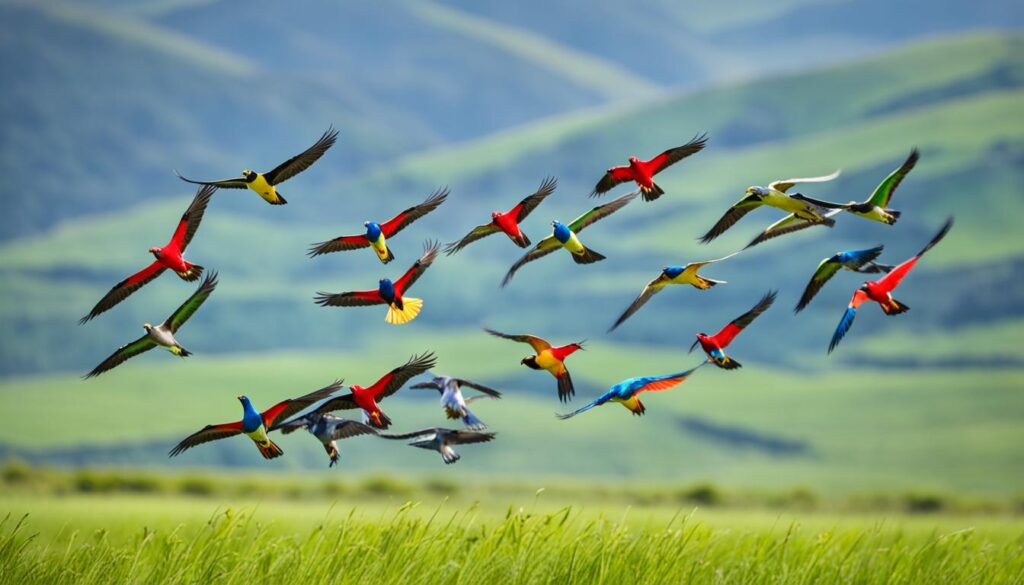
Snakes in the Food Chain
Snakes play a key role in the food chain as both predators and prey. They eat smaller animals like rodents and insects, helping to keep their populations in check. But, they are also food for bigger animals like birds, mammals, and other reptiles.
Birds like eagles, falcons, and hawks help keep the ecosystem balanced by eating snakes. They use their sharp claws and beaks to catch and eat snakes. Owls, with their great night vision, also hunt snakes at night.
The relationship between birds and snakes is crucial for a healthy ecosystem. Without snakes, the number of rodents could grow too high, causing problems for both the environment and the economy.
“Snakes are an essential part of the food chain, serving as both predators and prey. Their presence helps maintain the delicate balance of ecosystems, regulating the populations of smaller animals and providing sustenance for larger predators.”
Other animals, such as herons, egrets, cranes, roadrunners, and kites, also help control snake populations. They use different hunting methods to catch and eat snakes.
Snakes are vital in the ecosystem because they are both hunters and hunted. They keep the populations of many animals in check, making sure the environment stays stable. Knowing how snakes and their predators interact is important for protecting nature.
Ophiophagy in Other Animals
While birds are the main focus here, not all animals eat snakes. Many mammals, like honey badgers, mongooses, canids, and big cats, also eat snakes. They have special ways and strategies to hunt and eat snakes.
Mammalian Snake Predators
The Virginia opossum is very good at eating snakes. Mongooses can also eat snakes because they have a special way to resist snake venom. American badgers eat many things, including rattlesnakes, frogs, and even dead animals.
Fish and Reptiles that Eat Snakes
Some fish, like catfish and pike, and reptiles, including monitor lizards and crocodiles, also eat snakes. The King Cobra mainly eats other snakes, mostly the non-venomous ones. This shows how important snakes are in many food chains.
From ophiophagous mammals to ophiophagous fish and reptiles, many animals eat snakes. They have developed special ways to hunt and eat these snakes.
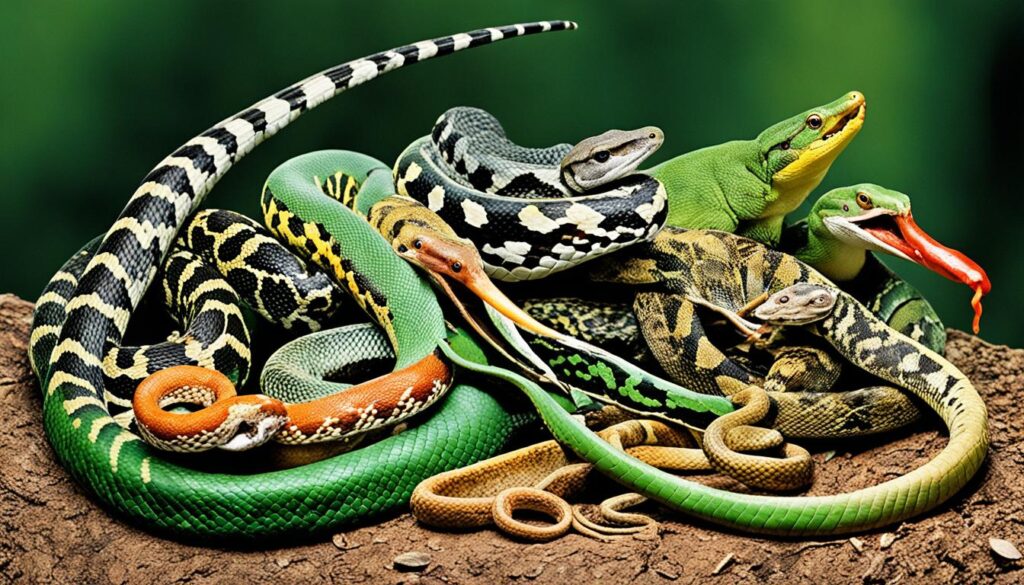
“Farmers in some regions keep ophiophagous animals to control snakes, such as cobras and pit vipers, which cause numerous deaths among domestic animals and humans annually.”
Unexpected Snake Predators
Birds, mammals, fish, and reptiles are often seen as snake predators. But, some insects and arachnids also hunt snakes. These ophiophagous species show how diverse and complex predator-prey relationships are in nature.
Insects and Arachnids that Prey on Snakes
Tarantulas and giant water bugs are insects that eat snakes, especially young or injured ones. They are strong and have special traits to catch and eat snakes. Arachnids like golden silk orb-weavers and redback spiders also eat small animals that hunt snakes.
In Texas, a gopher snake caught a horned owl during a hunt, killing it. Another story from Arkansas in 1999 tells of a great horned owl found dead with a southern black racer around its neck. This snake had stopped the owl from flying away.
These unexpected snake predators show how complex and surprising nature can be. Even small creatures can have a big impact on the food web.
The Cultural Significance of Eating Snakes
Humans have a long history of eating snake meat all over the world. It’s not common in the West, but in Southeast Asia, China, and the Southern United States, it’s a big deal. People see it as important in their food traditions.
Traditional and Contemporary Snake Meat Cuisine
There are many ways to prepare snake meat, like skinning, deboning, and boiling, frying, or grilling it. People eat snake meat for its health benefits or as a special treat in their culture.
In traditional snake meat dishes, the meat is loved for being low in fat but high in protein. For instance, rattlesnake meat is a big deal in the American Southwest. It’s known for its unique taste and health claims.
Now, contemporary snake cuisine is getting popular too. Chefs and food lovers are finding new ways to use snake meat in modern dishes. You can find snake meat in many kinds of food, from fancy restaurants to street food.

“The consumption of snake meat is often associated with beliefs about its potential health benefits or as a delicacy in certain cultural contexts.”
Snake meat has been a part of many cultures for a long time. It shows how important snake meat is in our food traditions. It’s a sign of how different cultures have made snake meat a big part of their food stories.
Balancing the Ecosystem
The birds that eat snakes are key to keeping their ecosystems in balance. These avian snake predators keep snake populations from getting too big. This stops them from taking over and harming other plants and animals.
By preying on snakes, these birds make sure snakes don’t overpopulate. This lets other species thrive. It’s a vital part of keeping the environment healthy and diverse.
This predator-prey relationship is crucial for the health of the places where these ophiophagous birds live. Without them, snake numbers could get out of control. This could harm other animals and disrupt the ecosystem.
“Snakes are important for maintaining the balance of ecosystems by keeping prey species such as rodents and spiders in check.”
The role of snake-eating birds in ecosystems is huge. They help control snake populations. This shows how important avian snake predators are for the health of their habitats.
Snake-eating birds are key species that keep their ecosystems balanced. They show us the complex relationships in nature. This highlights why we need to protect these amazing birds.
Key Snake-Eating Bird Species
Many bird species eat snakes, but some are experts at it. Key avian snake-eaters like eagles, hawks, owls, secretary birds, and roadrunners have special skills. They can find, catch, and defeat snakes with ease.
Specialized Snake Hunters
Birds with adaptations for snake hunting have great vision, speed, and agility. They also have strong talons and beaks. These features help them be apex predators in their habitats. They hunt snakes in different ways, from flying high to hiding in ambush.
- Eagles, like the bald and golden eagles, use their sharp eyes and strong talons to grab snakes from the ground or while they’re flying.
- Hawks and falcons are fast and agile. They catch snakes in mid-air.
- Owls are nocturnal snake predators. They fly quietly and see well at night, catching snakes by surprise.
- Secretary birds have long legs and eyes that look straight ahead. They hunt snakes by stomping on them with their strong feet.
- Roadrunners are fast and have strong beaks. They chase and hit snakes to kill them.
Key bird species that eat snakes are important for their ecosystems. They keep snake numbers in check and stop invasive species from spreading.
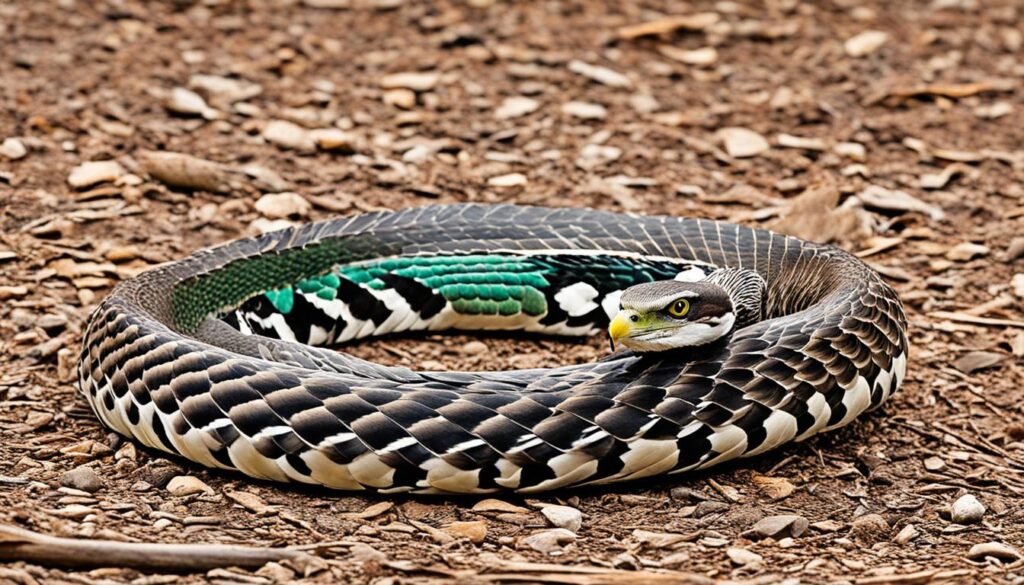
Fascinating Facts About Avian Ophiophagy
The world of birds that eat snakes is full of interesting facts. These birds have special ways to hunt and eat snakes. They also play a big role in many cultures around the world.
Some birds that eat snakes include Snake eagles, hawks, and Secretary birds. In some places, people keep Ophiophagos pet animals to help control snake numbers. For example, in India, people keep tamed mongooses for this purpose.
But, not all attempts to control snakes have worked out well. A plan in Brazil to breed and release Mussuranas to fight Pit vipers didn’t succeed.
One amazing thing about birds that eat snakes is they are not affected by snake venom. Mussuranas have special antibodies that protect them from venom. This lets them safely eat even the most venomous snakes.
These birds also have different ways to hunt snakes. For example, wild horses step on snakes to kill them. Hawks swoop down and then drop snakes from high up to catch them.
This article shows how birds and snakes have a complex relationship. Birds that eat snakes have special skills that help them survive. They also play a big role in many cultures. Ophiophagy is a fascinating part of nature.
Conclusion
Exploring birds that eat snakes shows us how diverse these bird species are. They have special ways to find, catch, and eat snakes. This helps control snake numbers and keeps ecosystems balanced.
This article looked into how birds and snakes interact in nature. It showed how birds are both predators and prey. We learned about the importance of birds eating snakes and their role in ecosystems.
Studying how birds eat snakes teaches us about their strength and how they fit into nature. These birds are key to their environments. We need to protect them to keep our planet healthy and full of life.
FAQ
What bird species are known to prey on snakes?
Many bird species, like eagles, hawks, and falcons, eat snakes. Owls, herons, egrets, cranes, roadrunners, and kites also do.
What is the term used to describe the feeding behavior of birds that consume snakes?
Birds that eat snakes are called ophiophagous. This means they eat snakes.
How have birds adapted to successfully hunt and consume snakes?
Birds that eat snakes have special traits. They have sharp senses, speed, agility, and some can resist snake venom.
What hunting techniques do birds use to capture snakes?
Birds use different ways to catch snakes. They swoop down, use strong talons, and beaks to grab and eat them.
How do birds that prey on snakes help maintain the balance of ecosystems?
Birds that eat snakes keep their numbers in check. This stops snakes from taking over, keeping the ecosystem balanced.
Are there any birds that have developed resistance or immunity to snake venom?
Yes, some birds can resist or be immune to snake venom. This lets them safely eat venomous snakes.
Are there any unexpected animal groups that have been observed preying on snakes?
Yes, insects like tarantulas and giant water bugs eat snakes. Arachnids like golden silk orb-weavers and redback spiders do too.
Do humans consume snake meat, and if so, in what cultural contexts?
Humans have eaten snake meat for a long time. It’s part of the food culture in places like Southeast Asia, China, and the Southern United States.
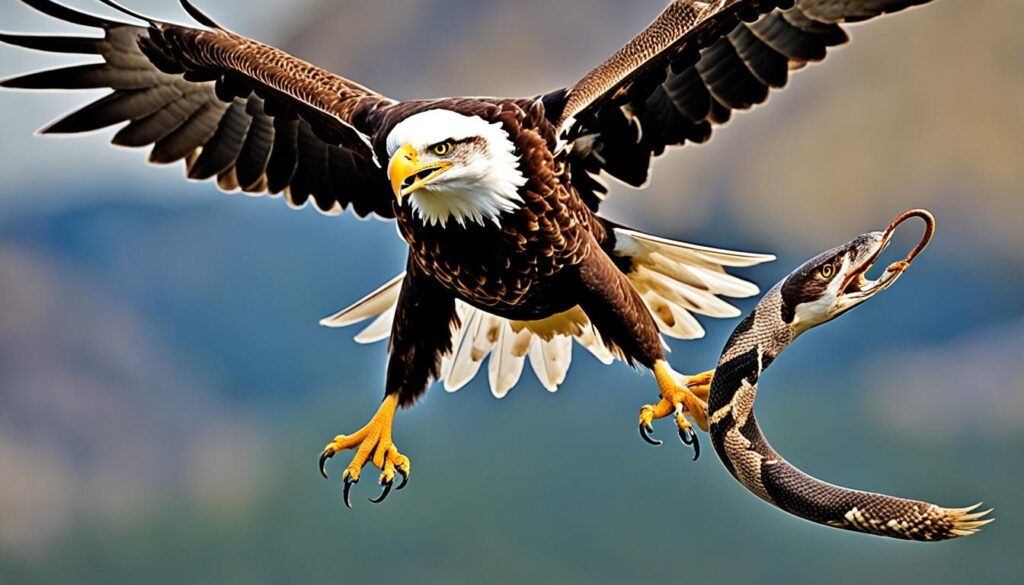

I’m really inspired along with your writing
abilities as smartly as with the layout for your blog. Is that this a paid
subject matter or did you modify it yourself?
Anyway keep up the nice high quality writing, it’s rare to peer a nice blog like this one
these days. Blaze ai!
аккаунты с балансом маркетплейс аккаунтов
купить аккаунт https://marketplace-akkauntov-top.ru/
маркетплейс для реселлеров магазин аккаунтов
купить аккаунт платформа для покупки аккаунтов
продажа аккаунтов аккаунт для рекламы
перепродажа аккаунтов маркетплейс для реселлеров
продажа аккаунтов соцсетей https://pokupka-akkauntov-online.ru/
Sell accounts Buy Account
Account Buying Service Account Selling Platform
Buy and Sell Accounts socialaccountsmarket2025.com
Social media account marketplace Buy accounts
Sell Account Accounts marketplace
Buy Account socialaccountsstore.com
Account Trading Account Catalog
Ready-Made Accounts for Sale Ready-Made Accounts for Sale
Secure Account Purchasing Platform https://accountsmarketplaceonline.com/
Account Selling Service Ready-Made Accounts for Sale
Account Purchase Verified Accounts for Sale
secure account purchasing platform sell pre-made account
sell accounts buy account
account sale account buying platform
account trading service buyaccountsdiscount.com
buy and sell accounts account store
purchase ready-made accounts account selling service
marketplace for ready-made accounts account marketplace
database of accounts for sale secure account sales
gaming account marketplace account buying platform
account trading service website for selling accounts
find accounts for sale secure account sales
ready-made accounts for sale account buying service
account trading platform account selling service
account trading platform verified accounts for sale
account trading service account trading service
verified accounts for sale purchase ready-made accounts
buy pre-made account account selling service
account acquisition accounts for sale
guaranteed accounts https://buy-social-accounts.org/
secure account sales verified accounts for sale
sell pre-made account https://accounts-market-soc.org
accounts market online account store
account buying service account trading platform
sell account find accounts for sale
account sale account selling service
website for selling accounts sell account
accounts for sale buy and sell accounts
account trading https://accounts-offer.org
sell accounts account market
account exchange service https://buy-best-accounts.org/
online account store https://social-accounts-marketplaces.live
marketplace for ready-made accounts accounts market
profitable account sales account marketplace
database of accounts for sale buy accounts
online account store https://buy-accounts-shop.pro/
buy pre-made account https://buy-accounts.live
account market social-accounts-marketplace.live
account market https://accounts-marketplace.online
accounts market accounts market
продать аккаунт магазины аккаунтов
купить аккаунт rynok-akkauntov.top
маркетплейс аккаунтов соцсетей https://kupit-akkaunt.xyz/
магазин аккаунтов akkaunt-magazin.online
магазин аккаунтов https://akkaunty-market.live
продать аккаунт kupit-akkaunty-market.xyz
продажа аккаунтов https://akkaunty-optom.live/
продать аккаунт online-akkaunty-magazin.xyz
маркетплейс аккаунтов соцсетей akkaunty-dlya-prodazhi.pro
продать аккаунт kupit-akkaunt.online
facebook ad account for sale https://buy-adsaccounts.work
facebook account buy buying fb accounts
buy facebook accounts for ads https://buy-ad-account.top/
facebook ad account buy https://buy-ads-account.click/
buy facebook ad account https://ad-account-buy.top
facebook ad account for sale https://buy-ads-account.work
buy facebook accounts for ads https://ad-account-for-sale.top
facebook accounts for sale https://buy-ad-account.click/
buy facebook profile facebook account buy
adwords account for sale https://buy-ads-account.top
buy google adwords account https://buy-ads-accounts.click
facebook ad account for sale https://buy-accounts.click
buy google ad account buy verified google ads accounts
adwords account for sale buy aged google ads account
google ads account buy https://buy-ads-invoice-account.top
buy google ads https://buy-account-ads.work/
buy aged google ads account google ads account buy
buy aged google ads accounts buy google ads threshold account